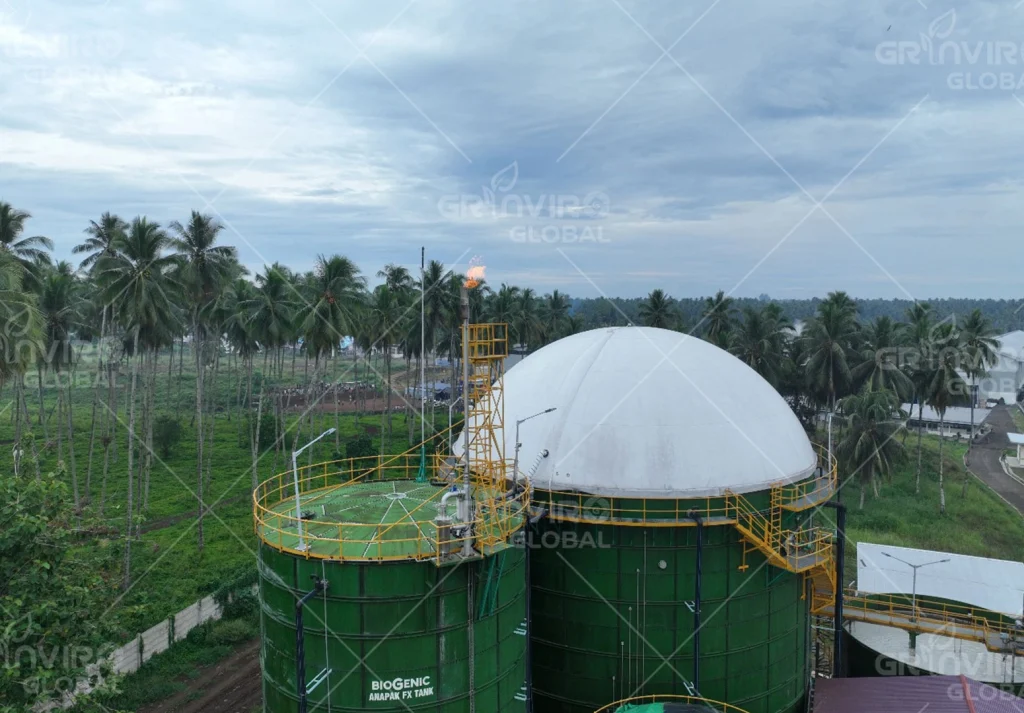In the palm oil industry, Palm Oil Mill Effluent (POME) is a byproduct of the palm oil extraction process. The treatment of POME has become essential to reduce environmental contamination and optimize the potential for renewable energy generation. One of the key components in improving the efficiency of wastewater treatment plants handling POME is the implementation of biogas flare stacks within BIOGENIC Waste to Energy systems. These flare stacks play a crucial role in safely managing excess biogas, reducing emissions, and contributing to energy recovery.
The Environmental Challenge of POME
POME is a wastewater produced during the extraction of palm oil, consisting of high levels of organic matter, fats, oils, grease, and nutrients, making it difficult to treat. Without proper management, POME can lead to environmental issues such as water contamination and soil degradation. To avoid these problems, efficient treatment methods are required, and one common approach is anaerobic digestion, which breaks down organic matter in the absence of oxygen and produces biogas, primarily methane.

However, the anaerobic digestion process generates significant amounts of biogas, which must be properly managed to avoid environmental impacts, particularly the release of methane, a potent greenhouse gas. This is where biogas flare stacks come into play.
The Role of Biogas Flare Stacks in Wastewater Treatment
Biogas flare stacks are integral to managing excess biogas produced during the anaerobic digestion process. Within BIOGENIC Waste to Energy systems, these flare stacks serve to safely combust methane, converting it into carbon dioxide, a less harmful greenhouse gas in terms of global warming potential. The integration of flare stacks within the BIOGENIC system ensures the efficient handling of biogas, optimizing energy recovery and contributing to the overall operational efficiency of wastewater treatment plants.
1. Efficient Biogas Combustion
The primary function of biogas flare stacks within BIOGENIC Waste to Energy systems is to efficiently combust excess biogas. By burning methane, flare stacks convert it into carbon dioxide, ensuring that methane levels are controlled and preventing its release into the atmosphere. The controlled combustion process reduces the risk of hazardous situations and ensures that excess biogas is safely managed.
2. Enhancing Energy Recovery
Rather than flaring biogas directly, the BIOGENIC system captures the methane for energy production. By harnessing biogas as a renewable energy source, the system reduces reliance on external power sources and enhances energy recovery. This energy can be used to power the treatment plant itself, improving the efficiency of operations and reducing energy costs.
3. Advanced Flaring Technology
The BIOGENIC system integrates advanced flaring technologies to optimize the combustion process. These technologies ensure that biogas is flared at optimal temperatures and pressures, improving the efficiency of biogas flare stacks. This results in cleaner combustion, fewer pollutants, and better overall performance.
4. Ensuring Compliance with Regulations
Biogas flare stacks within the BIOGENIC system help wastewater treatment plants comply with local and international environmental regulations. The system is designed to meet emission standards, ensuring that the plant operates within legal limits and avoiding penalties. This compliance also contributes to the plant’s reputation by demonstrating a commitment to environmental responsibility.
BIOGENIC Waste to Energy Solutions and the Impact on POME Treatment
Grinviro Global’s BIOGENIC Waste to Energy solutions optimize the use of biogas flare stacks in wastewater treatment plants processing POME. The system improves the efficiency of biogas production and energy recovery by enhancing the anaerobic digestion process and integrating advanced flaring technology. This holistic approach to managing biogas production and recovery ensures that POME is treated effectively while minimizing the environmental impact of the treatment process.
1. Optimized Biogas Production
BIOGENIC Waste to Energy solutions maximize biogas production during the anaerobic digestion process, ensuring that methane is captured and utilized efficiently. This optimization reduces the energy gap and ensures better management of biogas.
2. Energy Recovery Systems
Incorporating energy recovery systems, BIOGENIC captures the heat generated from the combustion of biogas. This heat is then used to generate electricity, improving the energy efficiency of the plant and reducing reliance on external power sources.
3. Long-Term Operational Benefits
The integration of biogas flare stacks and energy recovery systems within BIOGENIC Waste to Energy solutions enhances the overall efficiency of wastewater treatment plants. This not only reduces operational costs but also improves the plant’s long-term viability by ensuring that energy production and emissions are optimized for maximum effectiveness.
Read: Biological Wastewater Treatment for Dairy Industry: A Sustainable Approach 2025
The Broader Impact of Biogas Flaring in the Palm Oil Industry
As the global demand for palm oil continues to rise, the environmental footprint of palm oil production becomes an increasing concern. The palm oil industry is a major contributor to deforestation, greenhouse gas emissions, and biodiversity loss. However, by incorporating biogas flare stacks and renewable energy technologies, the industry can significantly reduce its environmental impact.
Biogas flaring, when combined with energy recovery, can offset a portion of the emissions generated by palm oil mills, making the industry more sustainable. Furthermore, by adopting technologies like BIOGENIC Waste to Energy from Grinviro Global, palm oil mills can contribute to national and international sustainability goals, such as reducing carbon emissions and improving renewable energy generation.
Conclusion
Biogas flare stacks are a critical component of the BIOGENIC Waste to Energy system in wastewater treatment plants processing Palm Oil Mill Effluent (POME). These flare stacks ensure the safe combustion of excess biogas, enhance energy recovery, and help plants comply with regulatory requirements. Through the use of advanced technology and efficient biogas management, BIOGENIC Waste to Energy systems provide a comprehensive solution for optimizing the treatment of POME while improving operational efficiency and energy recovery.

Visit Us:
- 7th floor,1#Building ,No.200 Sanmen Road ,Yangpu District ,Shanghai ,China
- The Prominence Office Tower Lt. 28, Jl. Jalur Sutera Barat, Tangerang
- Jl Utama Modern Industri Blok AA No.5, Kawasan Modern Industri Cikande
- Ciputra World Office Surabaya Lt. 29, Jl. Mayjen Sungkono, Surabaya
- Pattene Business Park Blok W3a Makassar
